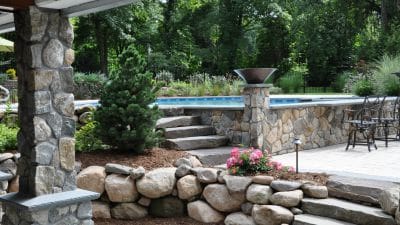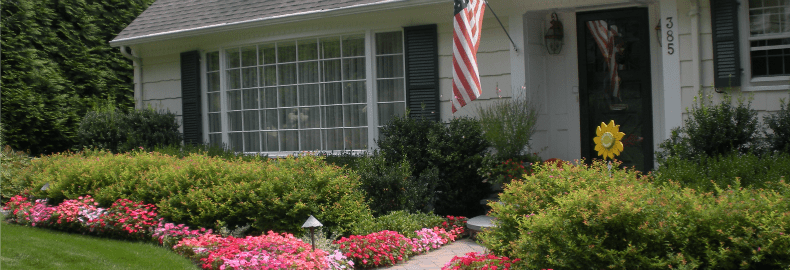 A beautiful landscape has a big impact on your home’s appearance and curb appeal. The plants and landscaping materials you choose will add depth, height and visual interest to your property. By selecting the right plants and materials, you can create a residential landscape design in NJ that reflects your home’s architectural features and design style.
A beautiful landscape has a big impact on your home’s appearance and curb appeal. The plants and landscaping materials you choose will add depth, height and visual interest to your property. By selecting the right plants and materials, you can create a residential landscape design in NJ that reflects your home’s architectural features and design style.
A well-designed landscape should not only compliment your home’s style, but it should also take into account your existing property layout, the size of your yard, soil conditions, drainage conditions and sun and shade requirements. When choosing plants and landscape materials, your existing property conditions can have a big impact on your choices. To achieve the best results, it’s best to work with a professional landscape company that’s knowledgeable and experienced in residential landscape design in NJ.
When designing your landscape, consider plants and hardscape materials for patios, terraces, driveways, walkways and pathways that work with your existing property conditions and compliment your home’s architectural features. There’s a lot of choices, so stay focused on plants and materials that will add the right amount of visual interest and contrast to compliment your house.
Traditional Landscapes
Traditional architecture typically emphasizes symmetrical design features, sophisticated colors and textures and old-world character. Traditional architecture includes a variety of home design styles such as Old English, Colonial, Cape Cod, French Normandy and Cottage. Imagine yourself transported to 17th century Franc, strolling through the garden paths at Versailles. Traditional landscapes are always well-maintained, neat and tidy, even if the layout isn’t typically symmetrical. Today’s traditional landscapes often include cutting gardens full of beautiful flowers, edible gardens and grand outdoor living elements like outdoor terraces and fireplaces. Traditional hardscaping materials are usually natural stone, brick and wood.
There’s really no right or wrong choices for traditional plants, but landscapes usually include plants with strong structures and showy blooms. Favorite traditional landscaping plants include evergreen hedges like boxwood, blue holly, cherry laurel and azaleas; flowering trees like dogwood, cherry, purple plum and callery pear; and ornamental grasses like fountain grass, maiden grass and “little bunny” grass. All of these plants are native to Northern New Jersey areas and will do well in residential landscape design in NJ.

Modern Landscapes
Modern architectural design has its roots anchored in the 1950s and 1960s, when the focus of contemporary style was on clean linear lines and geometric forms. Typical modern home features include large spans of glass, cantilevered beams, high ceilings, skylights and hard interior surfaces. Modern architecture emphasizes “more is less,” so interiors and exteriors promote simplicity and lack of embellishment.
Modern landscaping also focuses on these same design principles that promote a sleek, sophisticated style and clean, simple look. In modern landscapes, there’s a heavy emphasis on hardscaping materials, primarily concrete and natural stone because of their sterile appearance. Landscapes often include concrete, stone or gravel pathways, outdoor fireplaces or fire pits and well-manicured, simple plants.
A popular trend in today’s modern landscapes includes a hardscape area planted with a grid of greenery. Designs include paving stones with grass growing where the grout should be, or concrete sections spaced out with grass planted between the sections. Modern landscapes feel organized and controlled with plants that emphasize greenery, shape, texture and contrast. Pops of color are usually limited to areas like the front entry, backyard deck or patio, along walkways or pathways or garden areas. The pops of color are meant to provide stark contrast against hard surfaces that are sleek and sophisticated.
Plants are usually simple and easy to maintain. Good plant choices for modern residential landscape design in NJ include evergreens like Alberta spruce, Japanese holly, Russian arborvitae and viburnum. Ornamental grasses like blue fescue, zebra grass and morning light grass will provide lots of texture, while Shenandoah grass will add pops of red color in the summer and the fall.
Spanish Landscapes
Spanish architecture, a popular style today around the country, is heavily influenced by Persian, Moorish and Spanish design principles. They typically include features like walled sections with intimate patio areas, courtyards with spectacular fountains, tiled reflecting pools, symmetrical planting beds and terraces with beautiful landscaped views. Spanish landscapes are often adorned with outdoor arched fireplaces, tiered fountains, colorful Saltillo tiled patios, large stone urns or terra cotta pots and hanging lanterns. Spanish architecture often reflects strong color palettes in red, orange, yellow, blue in both bright and more muted hues.
A main element in Spanish landscape design includes private garden spaces. Whether it’s a walled-in patio area, a central courtyard or a remote terrace in the yard, the focus is always on privacy. With a large yard, you may be able to create several private spaces, but if your yard is small, you can select a quiet corner in the yard. Create focal points in specific areas with a fountain or reflecting pool, and allow plenty of room for a nice outdoor entertainment area with an outdoor kitchen. Spanish landscape design is all about privacy, relaxation and enjoyment with attention to detail.
Spanish gardens usually contain drought-tolerant plants that compliment the architectural style of the house. Since Spanish architecture originated in countries with hot, dry climates, large grassy lawns don’t reflect a realistic landscape. For Spanish residential landscape design in NJ, choose drought-tolerant plants to create an authentic Spanish style landscape. Good tree choices include river birch, American holly, pfitzer juniper and redwood. Native drought-tolerant shrubs include New Jersey tea and maple leaf viburnum. For touches of color in your landscape, use goldenrod, blazing star, blue hibiscus or red flowering currant .
Japanese Landscapes
Traditional Japanese landscapes are always designed for peaceful meditation, where visitors can experience a rather spiritual journey. The focus is on nature and the simplicity and tranquility that it provides. Japanese landscapes and gardens emphasize harmony and order between people and nature. There are four essential elements used in Japanese landscape design – water, plants, rocks and ornaments. When selecting and arranging these elements in your landscape, the finished design should always include asymmetry, good balance and well-organized spaces.
If you’re creating a Japanese residential landscape design in NJ, it’s important to use natural, simplistic hardscape materials that blend effortlessly into the landscape. The materials used for walkways, pathways or stepping stones should not become a focal point in the yard. Traditionally, when hardscaping is done in Japanese landscapes and gardens, natural stones and gravel are used and exposed aggregate concrete is often used as a paving material. Exposed aggregate resembles gravel and it’s available in a wide range of colors, but Japanese style usually focuses on earthy colors like cream, tan or brown for a more organic look. When installing hardscapes, avoid straight lines. Japanese landscape design emphasizes free-form, organic shapes that are more common in nature. You can also pour concrete in sections with unpaved space between them where grass can grow. This design helps to achieve unity and balance between man and nature, an important Japanese design principle.
Rock gardens are also quite common in Japanese landscaping. In Japanese culture, rocks stand for desire and power. In a Japanese Zen garden, rocks are meant to represent islands. They are surrounded by areas of raked gravel which is meant to represent water around the islands. In Japan, placing rocks within a landscape is considered to be a spiritual and artistic process. In Japanese rock gardens, rocks always have natural shapes, a variety of sizes and are often black or dark in color, like black granite. If you’re interested in creating a Japanese rock garden for your residential landscape design in NJ, talk to a landscape professional who can create a garden design that incorporates important elements.
Japanese gardens are typically full of lush, green plants in a variety of shapes, sizes and textures. Popular trees include black pine and Japanese maple which are symbolic of endurance and strength in Japanese culture. Popular plants include Japanese barberry, Japanese sweet flag, ferns and hosta. Moss is a common ground cover, and azaleas are often used for color. When planting, keep the Japanese design concepts of asymmetry and good balance in mind.

Specialty Landscapes
Sloped and Hilly Landscapes
Hillside landscaping is always a challenge. Whether you have a natural, undisturbed slope or one that’s terraced and maintained, there are five important things to remember when planning your residential landscape design in NJ:
- Preserve your view
- Reduce the slope as gradually as possible
- Use woody plants with deep roots to create slope stability
- Protect soil to prevent erosion
- Provide adequate irrigation with proper drainage
- Plan for accessibility and maintenance
According to statistics, many more homes built on slopes and hilly landscapes are lost to fire than homes built on level ground. This is because fire moves on land like water, only in the reverse. When vegetation at the bottom of the slope starts to burn, heat rises, and fire starts to move up the slope towards the house. If your home is built on a steep slope, or you have a drop off in your yard, work with a qualified, professional landscape company that’s experienced in this type of residential landscape design in NJ.
Small Yards
For small yards, landscape design needs to be very detail-oriented because there’s no room for error. Mistakes that can be hidden in a large yard are quite obvious in a small yard. It doesn’t take much for things to look out of place, out of scale and out of character with the rest of the landscape and the house. Although it seems like designing a landscape for a small yard would be easier, just the opposite is true. It’s actually more difficult because everything – scale, placement, shape, color and texture – are all so visible.
Small landscapes and gardens can range from quaint cottage-style designs to modern, urban designs, but they have to accommodate a small space. Often, dwarf plant species or miniature plant species are used to keep plants in the right scale. If you have a small yard, you can still create a beautiful landscape, just concentrate on lower height plants, colorful ground covers and smaller hardscaped areas.

Urban Landscaping
Today, urban living is very popular, especially with young professionals who want all the advantages of an inner-city lifestyle. Creating an inviting outdoor living space on an urban rooftop, balcony or terrace may be a little more challenging, but not impossible. Urban residential landscape design in NJ often involves creating an outdoor landscape a few feet or a few stories above street level. If you have an urban lifestyle, but want a beautiful outdoor space follow these important tips:
- Preserve Your View – The view from a rooftop garden is a valuable amenity, so don’t lose it or disguise it. Use plants that provide privacy but don’t interfere with your view. Whether you select evergreens or blooming plants, keep plant heights low and plants well-maintained all year.
- Protect Your Privacy – Urban balconies and terraces typically overlook other buildings, so screening off your neighbors can give you privacy for relaxing or entertaining outdoors. If you build partitions, remember that solid walls will prevent airflow and sunlight. Consider an open lattice partition, then cover it with climbing vines or pots with beautiful flowers.
-
- Plan For Seasonal Changes – With an urban garden, it’s important to consider Northern New Jersey weather and climate conditions year-round. Your outdoor space should look as good in the winter as it does in the spring and summer. Keep your outdoor plants well-manicured, deadhead growth and plant winter-hardy varieties in cold weather.

